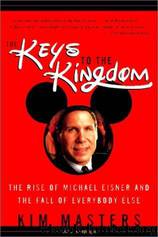The Keys to the Kingdom: The Rise of Michael Eisner and the Fall of Everybody Else by Kim Masters

Author:Kim Masters
Language: eng
Format: mobi
Tags: Non-Fiction, Business
ISBN: 9780066621098
Publisher: Harper Paperbacks
Published: 1999-01-02T00:00:00+00:00
ZEMECKIS HAD BEEN right. Katzenberg had become increasingly enamored of animation. Ron Clements, director of Disney’s next animated release, The Little Mermaid, was a Disney veteran who saw it happen. Like many animators, Clements had mixed feelings about Katzenberg’s growing involvement. “Jeffrey was right a good percentage of the time,” he says. “And sometimes he wasn’t right at all. There was a fair amount of arguing. He would always back down if you could convince him he was wrong. We would back down and he would back down. I think it had a lot to do with the success of the films…. But he could turn up the pressure. There’s good and bad in that. It got pretty stressful.”
Roy Disney had made another important contribution to the health of the division: he convinced Eisner to invest millions on the development of a sophisticated computer system that revolutionized production of the animated films. Rather than degrade the quality of Disney animation, the new system—which would be first used on parts of The Little Mermaid—freed the artists to create previously unfeasible sequences.
Ron Clements had pitched the idea for The Little Mermaid in his first “gong-show meeting” with Eisner and Katzenberg. They were intrigued by the idea but wanted to bring in live-action writers to do the script. Clements convinced them to let him and colleague John Musker take a swing at it. Katzenberg liked their script. The project was a go, with Clements and Musker directing.
Perhaps Katzenberg’s most important decision in animation came when he hired Howard Ashman and Alan Menken to write the music for The Little Mermaid. The Ashman-Menken collaboration would revitalize animation as a medium and bring back the musical as a popular form. The partnership also helped bring billions of dollars into the Disney coffers.
The first time Katzenberg heard Ashman and Menken’s music for The Little Mermaid, Clements said, he was entranced. “He started to get more and more into it,” he says. “But I think live action was [still] much more important to him. Animation was fun, but that didn’t put it in the same category as live action.”
Katzenberg’s relationship with Ashman was sometimes tempestuous. “Howard and Jeffrey would fight like cats and dogs,” remembers one animator. But Katzenberg managed to bring out some of the team’s most brilliant work. “Jeffrey knew how to edit, how to get a key change, knew when it wasn’t working,” that animator says. With no musical training, Katzenberg learned to trust the gut that no one thought he had. If a moment didn’t feel emotional enough, he pushed for something more.
As the film neared completion, Katzenberg told Clements that it would turn in a reasonable performance. But he warned that the movie probably wouldn’t do as well as Oliver & Company because The Little Mermaid seemed likely to appeal primarily to little girls. Such films didn’t perform as well as those that attracted boys.
Eisner took a few looks at the film as it progressed. In the first presentation, he heard some of the songs and listened to some of the voices.
Download
This site does not store any files on its server. We only index and link to content provided by other sites. Please contact the content providers to delete copyright contents if any and email us, we'll remove relevant links or contents immediately.
Life 3.0: Being Human in the Age of Artificial Intelligence by Tegmark Max(5452)
The Sports Rules Book by Human Kinetics(4276)
The Age of Surveillance Capitalism by Shoshana Zuboff(4194)
ACT Math For Dummies by Zegarelli Mark(3973)
Unlabel: Selling You Without Selling Out by Marc Ecko(3575)
Blood, Sweat, and Pixels by Jason Schreier(3554)
Hidden Persuasion: 33 psychological influence techniques in advertising by Marc Andrews & Matthijs van Leeuwen & Rick van Baaren(3456)
The Pixar Touch by David A. Price(3349)
Urban Outlaw by Magnus Walker(3323)
Bad Pharma by Ben Goldacre(3303)
Project Animal Farm: An Accidental Journey into the Secret World of Farming and the Truth About Our Food by Sonia Faruqi(3164)
Kitchen confidential by Anthony Bourdain(2994)
Brotopia by Emily Chang(2990)
Slugfest by Reed Tucker(2925)
The Content Trap by Bharat Anand(2851)
The Airbnb Story by Leigh Gallagher(2785)
Coffee for One by KJ Fallon(2549)
Smuggler's Cove: Exotic Cocktails, Rum, and the Cult of Tiki by Martin Cate & Rebecca Cate(2456)
Beer is proof God loves us by Charles W. Bamforth(2361)
